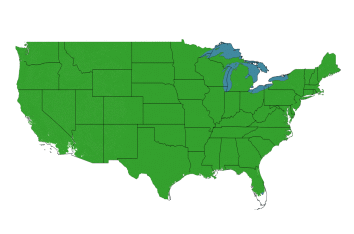✖
Hackberry Tree
Celtis occidentalis
As low as
$0.00
In stock
SKU
PFY-306
Fast-Growing Hackberry Tree For Shade or Street
- Native Tree Shelters and Feeds Birds
- Fast-Growing, Especially as a Young Tree
- Large-Scale Shade or Street Tree
- Great for Windy Areas
- Beautiful Fall Color
- Produces Small Berries that Feed Birds
- Provides Shelter for Birds
- Urban Tolerant
- Drought Tolerant
- Salt Tolerant
- Easy-Care
If you do a Google search on "best urban trees", Hackberry (Celtis occidentalis) should be listed. Although they are native to rich, bottomland soils, Hackberry trees are very tolerant of clay soils, pollution and salt.
They are adaptable to most soil types, including poor soils. Even if your thumb isn't green, you can grow a Hackberry as a very tough, fast-growing shade tree.
Today's trends have broadened to include a renewed interest in native trees, edible wildcrafted foods and eco-sensitive landscapes. It's time to include marvelous trees like Hackberry on the fashionable list.
These valuable trees are native to the Eastern and Midwest United States and have very few issues or problems. Municipalities and parks departments are increasingly using Hackberry as wonderful street trees in biodiverse plantings.
Plant one in your yard for its shade and seasonal interest, especially if you have a place where the soil is too poor for other trees.
Hackberry grows into an expansive shade tree for your yard with a cylindrical shape. This fast-growing, deciduous tree produces edible fruit.
5-inch alternate, green leaves feature yellow undersides and a rare offset base. The pretty leaves turn completely yellow in autumn for a showy accent in your yard.
Hackberry's foliage arrives at the same time as the small spring flowers, giving your tree a vivacious, lime-green appearance. Those flowers will eventually give way to small, edible berries that are dark purple.
The drupes have a somewhat date-like flavor and were traditionally used by Native Americans as a food source. They are a favorite of Cedar Waxwing, and other birds. You better believe they will also treasure the shelter and nesting opportunities Hackberry provides.
Common Hackberry is a wildlife tree, for sure.
The Hackberry's trunk has a distinctive, corky appearance. The ridges and blocky texture adds ornamental interest to the barren winter landscape, as do the tiny berries.
The wood is strong, and not prone to storm damage. It can be used for furniture or other projects.
Native Hackberry is a great way to have an impressive shade tree with ornamental appeal in less time than other large trees would require. The edible fruit sweetens the deal as a fun and useful addition to an already outstanding tree.
Order these long-lived, wind-tolerant, salt-tolerant trees from LetsPlantify.com. They'll stand up to heat, drought, and pollution. Feel great about your choice, your local birds will certainly be pleased.
How to Use Hackberry Tree in the Landscape
Try Hackberry as a long-lived shade tree. They are very tolerant of open, windy areas like you might find in new neighborhoods or developments, golf courses, parks and for street use.
Diversity of species is always important when developing a new urban forest. Nursery professionals and extension offices often recommend Hackberry.
Use Hackberry as a modern street tree planted 30 feet apart on center. Measure from the center of one tree to the center of the next.
Hackberry has remarkable adaptability. Use this tree when you have lawn areas with clay soils and in Rain Gardens to filter runoff from roofs before it flows down the storm sewer.
There is perhaps no better shade tree for wide, open areas. You simply won't have to fuss with it, just situate it on the south or west of your home. Allow that shade to reduce your energy bills!
Be sure to include Hackberry on Food Forests, in Wildlife Sanctuaries and other bird-friendly landscapes. Plant on the north side of a stand of Chickasaw Plum as a rugged, handsome backdrop.
#ProPlantTips for Care
Grow Hackberries in full sun or partial shade. Careful watering to establish the first season is always important, but they can be grown in wet or dry sites; in poor and clay soils with few problems.
Plant away from a driveway or patio because of its large size and the small, dark fruits that may drop. Hackberries are best when placed in the lawn to the south or west of seating areas. Use them correctly, and join the growing Hackberry Fan Club!
Hackberry trees are an important native species to support birds in your landscape. It is tolerant of most conditions, including drought, wind and urban conditions. Buy yours now!
| Botanical Name | Celtis occidentalis |
|---|---|
| Mature Height | 50 - 75 feet |
| Mature Spread | 25 - 40 feet |
| Soil Type | Widely Adaptable |
| Moisture | Low |
| Sun Exposure | Full Sun, Partial Shade |
| Growth Rate | Fast |
| Bloom Period | Early Spring |
| Flower Color | Green |
| Foliage Color | Green |
| Fall Color | Yellow |
| Pollinator Required | No |
| Pollinator Friendly | Yes |
| Growing Zone Range | 3-9 |

Write Your Own Review

